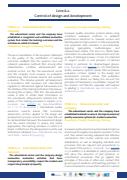Core 6.2. Control of design and development ITEM 6.2.1 Educational center and Company The educational center and the company have established a recognized and validated evaluation system that relates the learning outcomes and the activities on which it is based Completely / Enough / Something / Nothing The recommendations of the European Parliament on the quality of the certification of learning outcomes establish that the systems must use coherent evaluation methods that, among other characteristics, combine self-assessment and external control. For this, the educational center and the company must develop an evaluation methodology that includes internal and external evaluation. This includes periodic self-assessment in accordance with European and international regulations, national and regional frameworks or at the initiative of the training institutions themselves, including the company. With this, the educational center is able to obtain basic information on the educational achievements reached and the quality of the training processes it imparts. [one. European. See: EQAVET A4; Recommendation OJ C 111 of 06.05.2008 ] International quality assurance systems advise that summative assessment controls, applied to the design and development process, ensure that a clear link can be demonstrated between the assessment design and the results intended to assess, and where appropriate, the learning activities on which it is based. Furthermore, the rating system must be well defined and validated. [two. International. See: ISO 21001:2018 – Section 8.3.4.4.a) c)].Completely / Enough / Something / Nothing European quality assurance systems advise using consistent evaluation methods to establish performance indicators to measure success and identify areas for improvement. To this end, periodic and systematic data collection is recommended, applyingappropriatemethodologiesand measurement criteria. The aim is to obtain basic information on educational achievements and the quality of training processes. In turn, it is intended to support access to and provision of tailored training in particular for disadvantaged groups. [one. European. See: EQAVET A4, A8] International quality assurance systems advise that summative evaluation controls, applied to the design and development process, ensure that evaluation activities are carried out taking into account the principles of transparency, accessibility , respect for the student, and fairness, especially with respect to grading [2. International. See: ISO 21001:2018 – Section 8.3.4.4.b]. ITEM 6.2.3 Educational center and Company The educational center and the company have established methods to ensure the improvement of quality assurance systems for student evaluation Completely / Enough / Something / Nothing European quality assurance systems seek to improve and ensure the quality of evaluation systems. To this end, they advise including adequate and effective mechanisms that involve internal and external stakeholders, as well as designing standards and processes that are relevant and proportional to the needs of the sector [1. European. See: EQAVETITEM 6.2.2 Educational center and A1] In addition, it is advisable to adopt proceduresCompany The educational center and the company design that allow the detection of bad practices, or summative evaluation activities that have unauthorized procedures that go against the transparency, accessibility, respect the student and principles of the code of ethics and conduct that governs good academic and teaching practices. Itrespect the principle of equality is recommended to ensure that methods to detect
